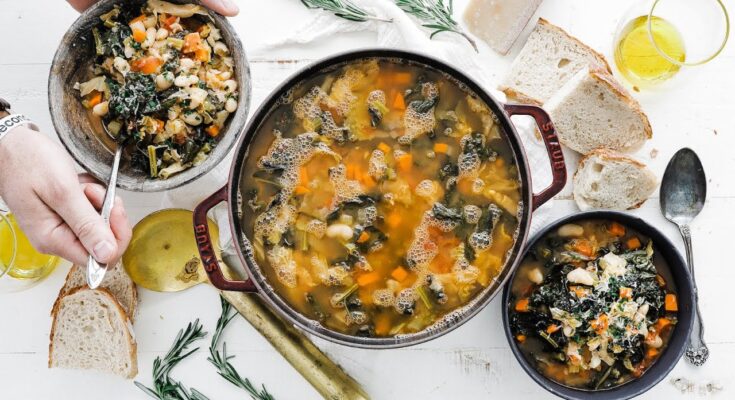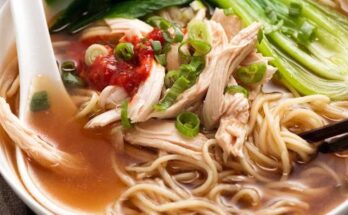Ribollita Recipe: Imagine a steaming bowl of rich, hearty soup, filled with slow-cooked vegetables, creamy beans, aromatic herbs, and thickened with rustic, stale bread—that’s ribollita in a nutshell. Pronounced ree-boh-LEE-tah, this dish is a traditional Tuscan soup that literally means “reboiled” in Italian. It’s more than just a meal—it’s a celebration of humble ingredients transformed into something incredibly comforting and nourishing.
Ribollita is not your typical light broth-based soup. It’s thick, chunky, and hearty, perfect for cold evenings or when you want something that feels like a hug in a bowl. The best part? It’s even better the next day. This is one of those rare recipes that truly improves over time, giving it a rich, deep flavor you just can’t rush.
Whether you’re an Italian food lover or a curious cook exploring plant-based meals, ribollita is one of those recipes that belongs in your regular rotation. It’s budget-friendly, nutritious, and incredibly satisfying. Ready to dive into a bowl? Let’s break it down, step by step.
History and Origins of Ribollita
Ribollita has humble peasant roots dating back to medieval Tuscany. Back then, food waste was not an option. Farmers and villagers made use of every last scrap of their ingredients, especially old bread and leftover vegetables. The result? Ribollita—a dish that showcases resourcefulness at its best.
In its earliest form, ribollita was simply a reheated vegetable and bread soup. Households would cook a large pot of vegetable soup, often using cavolo nero (Tuscan kale), carrots, beans, and onions. Any leftovers from that soup would be layered with stale bread and then “reboiled” the next day to create a new, thicker version of the original dish. This process of reboiling gave the soup its iconic name and signature texture.
Over time, ribollita became a symbol of traditional Tuscan cuisine, showing how simplicity and creativity can lead to unforgettable flavor. Today, it’s served in trattorias and homes all over Italy—and around the world—with each family putting their own spin on it.
Why You’ll Love This Classic Tuscan Soup
There’s something incredibly rewarding about making ribollita. Maybe it’s the aroma of garlic and rosemary wafting through your kitchen, or maybe it’s the way the stale bread transforms into a rich, velvety base. Here’s why this dish deserves a place in your recipe box:
- It’s Ridiculously Flavorful: Every spoonful is loaded with layers of taste—from the slow-cooked beans and savory vegetables to the earthy herbs and olive oil drizzle.
- It’s Filling and Comforting: Thanks to its dense texture and high fiber content, ribollita leaves you feeling full and satisfied without being heavy.
- It’s Budget-Friendly: Made with affordable pantry staples, ribollita proves that great food doesn’t have to cost a fortune.
- It’s Vegetarian (and Easily Vegan): The classic recipe is naturally meat-free, and it can be made entirely plant-based with no effort at all.
- It Gets Better with Time: Ribollita is one of those rare dishes that tastes even more amazing the next day. Perfect for meal prep and leftovers!
So whether you’re cooking for the week or hosting a cozy dinner, this is a dish that hits the spot—every time.
Ingredients You’ll Need
Core Vegetables for Ribollita
To make an authentic ribollita, start with a solid base of essential vegetables. These bring sweetness, earthiness, and texture to your soup:
- Cavolo Nero (Tuscan Kale): The soul of the dish. It adds a slightly bitter, deep green note. If you can’t find it, use lacinato kale or even curly kale as a substitute.
- Carrots: Adds natural sweetness and color.
- Celery: Offers a subtle crunch and aromatic base.
- Onions: The foundation of flavor. Yellow or white onions work best.
- Garlic: A few cloves add a punch of richness and depth.
- Tomatoes: A small amount of crushed tomatoes or tomato paste helps bring acidity and umami.
These vegetables are sautéed slowly to develop their full flavor, so don’t rush this part. Low and slow wins the race here.
Essential Herbs and Seasonings
What makes ribollita truly Italian is the seasoning. We’re not talking about fancy spice blends—just a few classic Mediterranean herbs will do the trick:
- Rosemary: Use fresh if possible. Its earthy, pine-like flavor is a must.
- Thyme: Optional, but it adds a lovely floral depth.
- Bay Leaf: One or two leaves bring a soft, rounded flavor.
- Salt and Pepper: Season in layers to bring everything together.
- Olive Oil: A generous drizzle of extra-virgin olive oil at the end ties all the flavors together. Don’t skip this—it’s magic in a bottle.
The Role of Stale Bread
This is where ribollita sets itself apart from any other vegetable soup. Instead of noodles or pasta, stale bread thickens and enriches the soup:
- Use Country-Style or Rustic Bread: Preferably unsalted and at least a day or two old. Tuscan bread is traditionally salt-free, which complements the soup’s seasoning.
- Tear It, Don’t Slice It: This gives a more rustic feel and helps it break down evenly in the soup.
- Layer and Simmer: You’ll layer the bread with the soup during the final stage, allowing it to absorb all the flavors and thicken beautifully.
If you’re tempted to use fresh bread—don’t. It will turn gummy. Stale is the way to go.
Optional Add-ins for Custom Flavor
While the traditional ribollita is a simple affair, you can tweak it based on what’s in your pantry:
- Cannellini Beans (Essential): Use dried and cooked beans for the best texture, but canned beans work in a pinch.
- Potatoes: Adds body and makes the soup even more filling.
- Zucchini or Leeks: Extra veggies for variation, especially in summer versions.
- Parmesan Rind: Toss one in while simmering for added umami (omit for vegan version).
- Crushed Red Pepper Flakes: If you like a little heat, sprinkle some in.
These additions don’t compromise the soul of the dish—they just add personality. Ribollita is very forgiving, so don’t be afraid to experiment.
Tools and Equipment Required
Kitchen Tools Checklist
To make the perfect pot of ribollita, gather these kitchen essentials:
- Large Dutch Oven or Heavy Pot: For even heat distribution.
- Chef’s Knife: To chop all your veggies with ease.
- Wooden Spoon: For stirring without scratching your cookware.
- Cutting Board: Preferably large enough for prepping all vegetables.
- Ladle: For serving thick soup neatly into bowls.
- Peeler and Colander: To prep and wash vegetables and beans.
These tools help streamline your cooking process, making it smooth and efficient.
Tips for Efficient Prep Work
- Prep All Veggies First: Chop and organize everything before turning on the heat. This mise en place saves time and stress.
- Use Canned Beans for Convenience: If you’re short on time, go for canned cannellini beans. Just rinse and drain them well.
- Make a Double Batch: Ribollita stores and reheats wonderfully. Cook once, eat for days!
How to Prepare Ribollita – Step-by-Step Guide
Step 1: Prepare the Vegetables
Start by washing and chopping all your vegetables — onions, carrots, celery, garlic, potatoes, cabbage (or kale), and tomatoes. Drain and rinse your cannellini beans if using canned ones. Keeping everything prepped makes the cooking smooth and satisfying, just like the dish itself.
Step 2: Sauté the Base Aromatics
In a large pot, heat olive oil over medium heat. Add chopped onions, carrots, and celery — the holy trinity of Italian soups. Sauté until they soften and turn slightly golden, then stir in minced garlic and a pinch of salt. This aromatic base sets the tone for the deep, comforting flavor of Ribollita.
Step 3: Simmer the Soup
Add chopped tomatoes, potatoes, and beans to the pot. Pour in vegetable or chicken broth, season with salt, pepper, and herbs like thyme or rosemary, and bring to a boil. Lower the heat and simmer for about 30–40 minutes until the vegetables are tender and the broth thickens naturally.
Step 4: Add the Bread and Finish Cooking
Tear day-old rustic bread into chunks and stir it into the simmering soup. The bread soaks up the broth, transforming it into a hearty, stew-like consistency. Cook for another 10 minutes until the mixture becomes thick and rustic.
Step 5: Rest and Reheat for True Flavor
Turn off the heat and let the Ribollita rest — traditionally, it’s even better the next day. When ready to serve, reheat gently with a drizzle of extra virgin olive oil on top. Each spoonful is earthy, rich, and timeless — a Tuscan classic that warms the soul.
Serving and Presentation Tips
How to Serve Ribollita Like a Local
Ribollita isn’t just soup—it’s a meal. In Tuscany, it’s served warm but never piping hot, in wide shallow bowls that show off the hearty texture and rustic charm.
To truly serve it like a local:
- Use Earthenware or Ceramic Bowls: These keep the soup warm and enhance the rustic aesthetic.
- Top with a Drizzle of Olive Oil: This isn’t optional—good-quality olive oil adds fragrance, flavor, and authenticity.
- Add a Cracked Egg (Optional): Some families crack a fresh egg into a steaming bowl of ribollita and let it poach in the heat.
- Serve with Red Wine: A medium-bodied Chianti complements the dish perfectly.
Presentation matters—even in a peasant dish. And ribollita, with its earthy charm, is proof that rustic doesn’t mean boring.
Garnishes and Pairings
Want to take your ribollita to the next level? Try these finishing touches:
- Shaved Parmesan or Pecorino Romano: Adds umami and a salty finish (omit for vegan).
- Fresh Basil or Parsley: A bright pop of color and freshness.
- Toasted Breadcrumbs: For a contrasting crunch on top.
- Grilled Bread on the Side: Because more bread is always a good idea.
Pair your bowl of ribollita with:
- A simple arugula salad dressed with lemon and olive oil.
- A glass of red wine—Chianti, Sangiovese, or Montepulciano.
- Roasted olives or marinated vegetables as a small appetizer.
These additions elevate your meal from rustic comfort to Tuscan bistro status—without leaving your kitchen.
Storage and Reheating Tips
How to Store Leftovers
Ribollita is a dream when it comes to leftovers. In fact, it’s one of those rare dishes that actually improves with age. As the soup sits in your fridge, the flavors mingle, the texture gets richer, and every bite becomes more satisfying.
Here’s how to store it right:
- Cool Completely: Before transferring ribollita to containers, let it cool to room temperature. This prevents condensation and helps avoid sogginess.
- Use Airtight Containers: Divide the soup into meal-sized portions in glass or BPA-free plastic containers. Airtight lids will lock in the flavor and prevent drying.
- Refrigerate for Up to 5 Days: Ribollita keeps well in the fridge. In fact, it’s best after a day or two, once it’s been “reboiled.”
- Freeze for Longer Storage: Want to keep it longer? You absolutely can! Ribollita freezes well for up to 3 months. Store it in freezer-safe containers or heavy-duty freezer bags. Just make sure to leave a little room for expansion as it freezes.
When freezing, it’s a good idea to portion it out. This makes thawing and reheating more manageable, especially for busy weekdays.
Reheating Without Losing Flavor
Reheating ribollita is where the magic really happens—it’s the “reboiling” process that gives this soup its name and soul.
To reheat:
- On the Stove: Transfer the ribollita to a pot and reheat over low heat. Stir occasionally and add a splash of water or broth if it’s too thick. This gentle reheating allows the flavors to develop even more.
- In the Microwave: If you’re in a rush, microwave it in short bursts (about 1–2 minutes at a time), stirring in between. Again, add a little liquid to bring it back to the right consistency.
- Add Olive Oil Again: A final drizzle of good-quality olive oil after reheating revives the soup and gives it that signature richness.
One of the best things about ribollita is that it doesn’t lose its charm with time. Unlike many other soups that turn mushy or bland after sitting, ribollita only gets better—and that’s the beauty of this timeless dish.
Health Benefits of Ribollita
Nutritional Highlights
Ribollita is more than comfort food—it’s a nutritional powerhouse. It delivers on flavor and function, making it ideal for anyone looking to eat clean, reduce meat, or just enjoy wholesome meals that feel good.
Here’s what you’re getting in every bowl:
- Fiber-Rich Ingredients: Thanks to beans, kale, and vegetables, ribollita is packed with both soluble and insoluble fiber. Great for digestion, heart health, and feeling full longer.
- Plant-Based Protein: Cannellini beans add a solid amount of protein without needing any meat. Perfect for vegetarians and vegans.
- Low in Saturated Fat: There’s no butter or heavy cream here. Just heart-healthy olive oil and clean veggies.
- High in Vitamins & Minerals: Kale provides Vitamin K, A, and C; carrots and tomatoes are rich in beta-carotene; and garlic brings anti-inflammatory properties.
- Low Glycemic Index: The use of whole vegetables and beans stabilizes blood sugar levels, making this meal suitable for diabetics and those watching their carb intake.
This makes ribollita an excellent choice for a Mediterranean diet, considered one of the healthiest eating patterns in the world. It’s anti-inflammatory, immune-boosting, and heart-friendly—all in one pot.
A Great Option for Plant-Based Diets
If you’re eating more plant-based meals—or fully vegan—ribollita is your new best friend.
Here’s why:
- No Animal Products (Traditionally): The classic recipe doesn’t include meat or dairy. Any cheese or meat is a modern addition.
- Easy to Adapt: Want to keep it vegan? Just skip the Parmesan rind and cheese toppings.
- Complete Meal: With beans, vegetables, and bread, it has all the macronutrients you need in one dish.
- Affordable and Accessible: You don’t need specialty ingredients. Everything is likely already in your pantry or available at your local store.
So whether you’re going full vegan or simply want to cut back on animal products, ribollita is a dish you can feel good about—physically, ethically, and financially.
Common Mistakes to Avoid
Overcooking the Vegetables
This soup is rustic, yes—but texture still matters. One common mistake? Overcooking your vegetables until they turn to mush. Ribollita should be thick, but not homogeneous.
Tips to avoid overcooking:
- Chop Veggies Uniformly: This ensures everything cooks at the same rate.
- Add Greens Late: Toss in kale or spinach during the last 15–20 minutes to keep their color and texture intact.
- Simmer, Don’t Boil: Gentle heat brings out the best in your ingredients without breaking them down too much.
Ribollita should feel hearty, not like baby food.
Using Fresh Bread Instead of Stale
The bread is what sets ribollita apart from other soups. It’s not just added for bulk—it transforms the dish. But fresh bread? That’s a no-go.
Here’s why:
- Fresh Bread Gets Gummy: It dissolves too quickly and doesn’t absorb flavor properly.
- Stale Bread Holds Shape: It thickens the soup while keeping a bit of structure.
- Flavor Absorption: Old bread is like a sponge, soaking up every drop of broth and seasoning.
If you don’t have stale bread on hand, toast some slices or cubes in the oven at 250°F (120°C) for about 15–20 minutes. Let them cool before adding to the soup.
Variations of Ribollita
Regional Twists
While the core ingredients of ribollita are consistent—kale, beans, and bread—different regions in Tuscany and beyond put their own spin on this iconic soup. Here are some of the most popular regional variations you might encounter:
- Florentine Style: In Florence, the soup often includes more tomato and sometimes leeks for added sweetness. The bread is layered in a casserole dish, then topped with soup and reheated in the oven, almost like a savory bread pudding.
- Siena-Inspired Ribollita: Siena’s version may include additional legumes like lentils or chickpeas, offering even more earthy flavor and texture.
- Pisan Ribollita: This twist leans on fewer tomatoes and more greens, often using chard or spinach alongside kale. It can also include a splash of red wine vinegar for acidity.
- Coastal Tuscany Version: On the coast, some recipes add seafood broth instead of vegetable stock for a briny, umami-packed punch. While not traditional, it’s a favorite among seafood lovers.
The essence of ribollita is adaptability. Don’t be afraid to try a variation that suits your regional ingredients or personal preferences.
Modern Interpretations
Ribollita might be an old-world dish, but modern chefs and home cooks are putting contemporary spins on it. Here are a few creative (yet delicious) interpretations:
- Ribollita with Pesto Swirl: A drizzle of basil pesto on top adds freshness and vibrant green flavor. Perfect for springtime.
- Gluten-Free Ribollita: Swap bread for gluten-free alternatives like toasted chickpeas or brown rice, or simply add more beans to thicken.
- Protein-Boosted Version: Add plant-based sausage or tempeh crumbles for a heartier version with extra protein.
- Slow Cooker or Instant Pot Ribollita: For busy weeknights, use your slow cooker or pressure cooker to prepare the soup. Just add the bread at the end.
- Smoky Ribollita: Add a dash of smoked paprika or use fire-roasted tomatoes to give the soup a bold, smoky undertone.
These modern takes retain the heart of the original recipe while making it work for different diets and lifestyles. Ribollita has evolved from a farmer’s dish to a gourmet delight—and it’s not done evolving yet.
FAQs about Ribollita Recipe
Can I Freeze Ribollita?
Absolutely. Ribollita freezes beautifully. Let it cool completely, then store in freezer-safe containers for up to 3 months. Thaw overnight in the fridge and reheat gently on the stove, adding a bit of water or broth if needed to revive the texture.
What Bread Works Best?
Rustic, crusty, unsalted country-style bread is ideal. Traditional Tuscan bread is made without salt, which allows the soup’s seasoning to shine. Make sure the bread is stale (1–2 days old) or toast it before using.
Is Ribollita Vegan?
Yes, the traditional version is naturally vegan. Just skip optional add-ins like Parmesan cheese or rinds, and ensure your broth is vegetable-based. It’s hearty, flavorful, and completely plant-powered.
How Long Should I Let It Rest?
Ideally, let ribollita rest overnight in the refrigerator. This allows the bread to fully absorb the broth and the flavors to deepen. Reheat gently the next day—this “reboiled” method is what makes it truly authentic.
Can I Use Canned Beans?
Yes! While dried beans offer better texture and flavor, canned cannellini or white beans are perfectly acceptable. Just be sure to drain and rinse them before adding to the soup to reduce excess sodium.
Conclusion
Ribollita is the definition of comfort food. It’s not just a soup—it’s a story in a bowl. A dish born from simplicity and necessity, transformed into one of Tuscany’s most iconic and beloved meals. With its rich layers of vegetables, creamy beans, hearty bread, and soul-soothing broth, ribollita brings warmth and nourishment like few other dishes can.
It’s affordable, easy to make, endlessly customizable, and tastes better with time. Whether you’re enjoying it fresh off the stove or reheated the next day (as tradition demands), ribollita never disappoints.
So go ahead—gather your ingredients, take your time building flavor, and embrace the beauty of reboiled soup. Once you’ve had your first bowl, you’ll see why ribollita has stood the test of time for centuries.



